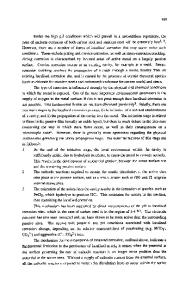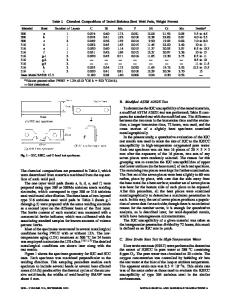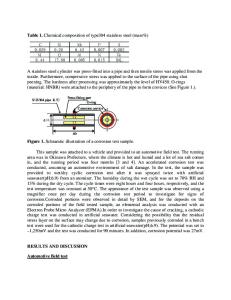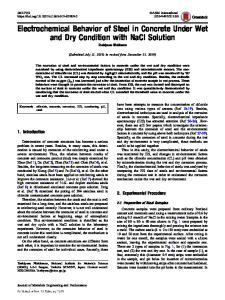Corrosion Behavior of Carbon Steel and Stainless Steel Materials under Salt Deposits in Simulated Dry Repository Environ
- PDF / 751,075 Bytes
- 7 Pages / 612 x 792 pts (letter) Page_size
- 14 Downloads / 361 Views
II4.14.1
Corrosion Behavior of Carbon Steel and Stainless Steel Materials under Salt Deposits in Simulated Dry Repository Environments Lietai Yang, Roberto T. Pabalan, Lauren Browning and Darrell S. Dunn Center for Nuclear Waste Regulatory Analyses, San Antonio, TX 78238–5166, U.S.A.
ABSTRACT In-situ coupled multielectrode array sensors were used to measure the non-uniform corrosion of carbon steel and stainless steel materials under KCl salt deposit in simulated dry repository environments. It was found that the initiation of non-uniform corrosion occurs at a relative humidity that is 14% lower than the deliquescence relative humidity of the chloride salt. It was found also that once significant corrosion had occurred, the non-uniform corrosion process for the carbon steel material under the salt deposit continues at relative humidities as low as 27%.
INTRODUCTION The deposition of aerosol and dust from ventilation air and the evaporation of water seeping into the drift of a proposed geologic repository at Yucca Mountain, Nevada, may lead to the accumulation of hygroscopic salts, such as KCl and NaCl, on the carbon steel ground support structures and on the surface of drip shields and waste packages [1–3]. At relative humidities at or above the deliquescence relative humidity (DRH) of the salt or salt mixture, these hygroscopic salts sorb moisture from the atmosphere and form a highly concentrated aqueous phase that could cause aqueous corrosion of metals. Initiation of aqueous corrosion of a metal is believed to occur at a critical relative humidity (CRH). In the Department of Energy’s modeling of the performance of waste package materials in the proposed repository, it was assumed that the CRH of the waste package materials is equal to the DRH of hygroscopic salts that could form on the waste package surface [4]. In our previous work [5], the conductivity of several salts and some of their mixtures that are likely to be present in the proposed repository system was measured as a function of relative humidity. It was found that the conductivity of a salt or salt mixture generally starts to increase at RHs that are about 15% to 20% lower than their DRH. Because ionic transport is a necessary condition for aqueous corrosion to occur, it was speculated that aqueous corrosion might initiate at RHs that are 15% to 20% lower than the DRH values. In the present work, a coupled multielectrode array sensor was used to study the non-uniform corrosion behavior of carbon steel materials and determine their CRH under NaCl and KCl salt deposits in simulated dry repository environments. To verify whether the use of CRH is valid for other alloys, the non-uniform corrosion behavior of type 316 stainless steel material was also measured in the same environment.
II4.14.2
EXPERIMENTAL The schematic diagram of the multielectrode sensor used in the experiments is shown in Epoxy Figure 1. The operating principle and the highcast resolution current-measuring system for the Sensing coupled electrodes have been described surface else
Data Loading...











